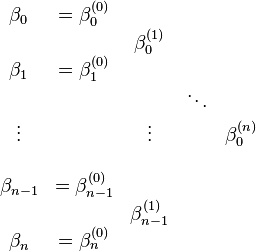De Casteljau's algorithm
In the mathematical field of numerical analysis, De Casteljau's algorithm is a recursive method to evaluate polynomials in Bernstein form or Bézier curves, named after its inventor Paul de Casteljau. De Casteljau's algorithm can also be used to split a single Bézier curve into two Bézier curves at an arbitrary parameter value.
Although the algorithm is slower for most architectures when compared with the direct approach, it is more numerically stable.
Definition
A Bézier curve B (of degree n, with control points  ) can be written in Bernstein form as follows
) can be written in Bernstein form as follows
 ,
,
where b is a Bernstein basis polynomial
 .
.
The curve at point t0 can be evaluated with the recurrence relation
Then, the evaluation of  at point
at point  can be evaluated in
can be evaluated in  steps of the algorithm. The result
steps of the algorithm. The result  is given by :
is given by :
Moreover, the Bézier curve  can be split at point
can be split at point  into two curves with respective control points :
into two curves with respective control points :
Example implementation
Here is an example implementation of De Casteljau's algorithm in Haskell:
deCasteljau :: Double -> [(Double, Double)] -> (Double, Double)
deCasteljau t [b] = b
deCasteljau t coefs = deCasteljau t reduced
where
reduced = zipWith (lerpP t) coefs (tail coefs)
lerpP t (x0, y0) (x1, y1) = (lerp t x0 x1, lerp t y0 y1)
lerp t a b = t * b + (1 - t) * a
Notes
When doing the calculation by hand it is useful to write down the coefficients in a triangle scheme as
When choosing a point t0 to evaluate a Bernstein polynomial we can use the two diagonals of the triangle scheme to construct a division of the polynomial
into
and
Example
We want to evaluate the Bernstein polynomial of degree 2 with the Bernstein coefficients
at the point t0.
We start the recursion with
and with the second iteration the recursion stops with
which is the expected Bernstein polynomial of degree 2.
Bézier curve
When evaluating a Bézier curve of degree n in 3-dimensional space with n+1 control points Pi
with
 .
.
we split the Bézier curve into three separate equations
which we evaluate individually using De Casteljau's algorithm.
Geometric interpretation
The geometric interpretation of De Casteljau's algorithm is straightforward.
- Consider a Bézier curve with control points
 . Connecting the consecutive points we create the control polygon of the curve.
. Connecting the consecutive points we create the control polygon of the curve. - Subdivide now each line segment of this polygon with the ratio
 and connect the points you get. This way you arrive at the new polygon having one fewer segment.
and connect the points you get. This way you arrive at the new polygon having one fewer segment. - Repeat the process until you arrive at the single point - this is the point of the curve corresponding to the parameter
 .
.
The following picture shows this process for a cubic Bézier curve:

Note that the intermediate points that were constructed are in fact the control points for two new Bézier curves, both exactly coincident with the old one. This algorithm not only evaluates the curve at  , but splits the curve into two pieces at
, but splits the curve into two pieces at  , and provides the equations of the two sub-curves in Bézier form.
, and provides the equations of the two sub-curves in Bézier form.
The interpretation given above is valid for a nonrational Bézier curve. To evaluate a rational Bézier curve in  , we may project the point into
, we may project the point into  ; for example, a curve in three dimensions may have its control points
; for example, a curve in three dimensions may have its control points  and weights
and weights  projected to the weighted control points
projected to the weighted control points  . The algorithm then proceeds as usual, interpolating in
. The algorithm then proceeds as usual, interpolating in  . The resulting four-dimensional points may be projected back into three-space with a perspective divide.
. The resulting four-dimensional points may be projected back into three-space with a perspective divide.
In general, operations on a rational curve (or surface) are equivalent to operations on a nonrational curve in a projective space. This representation as the "weighted control points" and weights is often convenient when evaluating rational curves.
See also
- Bézier curves
- De Boor's algorithm
- Horner scheme to evaluate polynomials in monomial form
- Clenshaw algorithm to evaluate polynomials in Chebyshev form
References
- Farin, Gerald & Hansford, Dianne (2000). The Essentials of CAGD. Natic, MA: A K Peters, Ltd. ISBN 1-56881-123-3
External links
- Piecewise linear approximation of Bézier curves – description of De Casteljau's algorithm, including a criterion to determine when to stop the recusion
- Bezier Curves and Picasso — Description and illustration of De Casteljau's algorithm applied to cubic Bézier curves.






![B(t) = \sum_{i=0}^n \beta_i^{(0)} b_{i,n}(t) \mbox{ , } \qquad t \in [0,1]](../I/m/4f18b70bfd0a1db79de863f656b7f34f.png)
![B_1(t) = \sum_{i=0}^n \beta_0^{(i)} b_{i,n}\left(\frac{t}{t_0}\right) \mbox{ , } \qquad t \in [0,t_0]](../I/m/2737855f54163a2f1a16b78dafb34e35.png)
![B_2(t) = \sum_{i=0}^n \beta_i^{(n-i)} b_{i,n}\left(\frac{t-t_0}{1-t_0}\right) \mbox{ , } \qquad t \in [t_0,1]](../I/m/1201df693e27062ace4c8649684a2f41.png)






![\mathbf{B}(t) = \sum_{i=0}^{n} \mathbf{P}_i b_{i,n}(t) \mbox{ , } t \in [0,1]](../I/m/ea8b41defda07c1a5c67cd306c577548.png)
![B_1(t) = \sum_{i=0}^{n} x_i b_{i,n}(t) \mbox{ , } t \in [0,1]](../I/m/fc7e01686e669b979bf14ab4a7b06238.png)
![B_2(t) = \sum_{i=0}^{n} y_i b_{i,n}(t) \mbox{ , } t \in [0,1]](../I/m/7902736879ad29b6380c50d4681bd537.png)
![B_3(t) = \sum_{i=0}^{n} z_i b_{i,n}(t) \mbox{ , } t \in [0,1]](../I/m/2863d0ab99d35e5dedb38f3b241bc5d8.png)